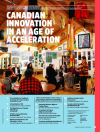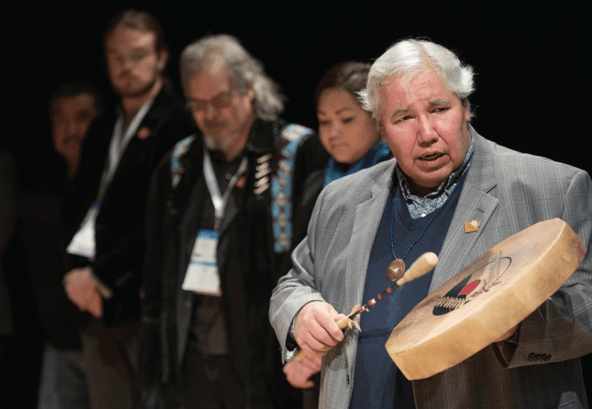Treaty 8 territory in Canada is home to the Dënesułiné and Cree people, the Regional Municipality of Wood Buffalo, and Canada’s largest oil deposits. The territory covered by the treaty, signed in 1899 between First Nations of Northern Alberta, northeastern British Columbia, northwestern Saskatchewan, the southwest portion of the Northwest Territories, and the queen of England, encompasses 840,000 kilometers. During the summer, berries grow in the northern boreal forest, not far from oil refineries, tailings ponds (where waste and by-products from the mines are captured by dams and dykes), and reclaimed land. There is a thin line between these two worlds. It is a line that many people on both sides of the divide tread, including myself. I am a Dënesułiné mother and daughter.
Canadian Innovation in an Age of Acceleration

This special supplement highlights innovative social programs, collaborations, and movements underway among Canada’s diverse communities—150 years after the country’s founding—and shares ideas for others involved in similar efforts around the world.
-
The Critical Role of Traditional Knowledge in Social Innovation
-
A New Model for CSR
-
The Digital Future of Canadian Philanthropy
-
A Path to Community Driven Food Innovation
-
Fighting Social Exclusion, One Encounter at a Time
-
Supporting Women’s Rights in Troubled Times
-
An Invitation to Explore Indigenous Innovation
-
Out of the Lab and into the Frontline
-
Crowdsourcing Refugee Resettlement
-
Building a Canadian Social Finance Fund
-
Canada and the Sustainable Development Goals
I sometimes feel like I am about to lose the delicate balance I keep. I am driven by a sense of duty, knowing that if I lose focus, the worlds will stay divided. For the past 12 months, I have been a fellow with the Alberta Social Innovation Connect (ABSI) initiative, a unique program seeking to identify and amplify social, economic, and ecological impact initiatives that are successfully challenging the status quo in Alberta. Specifically, I am working as the Northern Alberta Fellow, providing insights into the dynamics of Indigenous communities, both rural and urban. My mandate is to find and share local stories of Indigenous innovation, strengthen the capacity of Indigenous innovators and non-Indigenous collaborators, and look for emergent opportunities to support systems change. I have not had to look far: The desire for change in these communities is producing significant ideas and innovations at a grassroots level, rooted in traditional knowledge.
Creating new solutions to complex social problems is embedded in Indigenous people’s way of life; we have always invented new ways to flourish in poor conditions. We are very communal. My mother always tells me, “If you have more than one, you have enough to share.” We believe that what affects one person will eventually affect another, and we keep this in mind with every decision. I know that the rest of Canada, and the rest of the world, can benefit from a better understanding of these traditions. Social innovation has the potential to bridge Indigenous and non-Indigenous cultures and create a brighter future for all.
I believe that the distance between Indigenous and non-Indigenous ways of doing, being, and knowing is less one of geography or time than one of language. As an ABSI Fellow, I have been exploring the concept of social innovation with Indigenous elders in Treaty 8 territory. In Dënesułiné, social innovation translates to mean “to see from my position or perspective.” In Cree, the connotation is “to change the way I see things.” These translations reveal a depth of inherent understanding about social innovation often overlooked in Western-language definitions. Both the Cree and the Dënesułiné translations suggest that social innovation is primarily about relationships and understanding a different perspective, and less about the actual invention or implementation process. Social innovation is, at its heart, about changing how we live in the world together.
Canada is currently involved in an experiment to do just that. The proceedings of the Truth and Reconciliation Commission of Canada were a first step toward shifting the relationship between Indigenous and non-Indigenous people in Canada. The TRC exposed the cultural genocide that took place over seven generations as Canada’s residential school system removed Indigenous children from their communities and pressured them to assimilate into Western culture. (The last school closed in 1996.) The potential for reconciliation in the relationship between Indigenous and Western people in Canada is enormous; in theory, such a reconciliation would put us on the path to resolving multiple current and complex challenges, such as broken treaties, missing and murdered Indigenous women, inaccessibility of clean water, inequitable access to mental health services, and the high number of Indigenous children in government care.
However, the Canadian government’s history with Indigenous people has left us with a lack of confidence and a sense of mistrust in the health care, educational, and justice systems. To be successful, social innovation in these and other areas requires mutual respect and understanding; it cannot be a new imposition on us.
Finding Paths to Walk Together
Finding our way through the tensions will not be easy. During my fellowship, I have encountered two main challenges to bridging the divide between cultures and understanding:
One, it is part of Indigenous culture to pass on traditional knowledge orally. A common concern is that, when recorded, documented, and shared with exclusivity, traditional knowledge loses authenticity. Who tells what story is determined by the keeper of the story, often an elder. Elders decide who is fit to tell a story, to ensure that its moral is carried on. The concern stems from the possibility of a story being changed along the way by someone with intentions other than keeping the moral—sharing a story for profit, for example.
Two, language barriers make mutual understanding challenging. Outsiders commonly use the term “industry,” for example, when consulting with Indigenous people in Treaty 8 territory about the use of the land. Natural resource companies go to communities to represent and discuss their “industry”— these consultations are a Treaty requirement. But in Dënesułiné, “industry” connotes “destruction, loss, and extermination,” according to an elder from south of Wood Buffalo. A Cree elder who lives in the heart of the region’s oil sands gave me this translation: “profit, progress, growth.” These different translations create tensions when industry representatives try to consult and work with Indigenous people or develop solutions intended to respect their cultures, heritage, well-being, and livelihoods.
During my time as an ABSI fellow, I have wondered if a way to start building bridges would be to develop a common language through which we can build empathy with each other, find a common goal, and work toward it together—as urban and rural, Indigenous and non-Indigenous peoples. This common language would foster mutual understanding of significant words such as “success” and “justice.” To clearly articulate shared goals, such as bringing justice to the thousands of families of missing and murdered Indigenous women or what we mean by “high quality of life,” we need mutual understanding of the words we use. A common language would help restore trust and guide us on a path of reconciliation.
 Senator Murray Sinclair beats a drum at the 2015 Indigenous Innovation Summit, an annual event hosted by the National Association of Friendship Centres. (Photograph courtesy of the McConnell Foundation) Clarification: This caption has been modified to reflect that it features Sinclair.
Senator Murray Sinclair beats a drum at the 2015 Indigenous Innovation Summit, an annual event hosted by the National Association of Friendship Centres. (Photograph courtesy of the McConnell Foundation) Clarification: This caption has been modified to reflect that it features Sinclair.
I have been encouraged by the social innovation conversation among Indigenous people and non-Indigenous people in Wood Buffalo. These people include Cheryl Alexander, who is Indigenous to Treaty 8 land and focuses her efforts on cultural awareness training for industry, and the team at the Fort McMurray Multicultural Association, which encourages Indigenous people to preserve their cultures. In its efforts to promote inclusion, the Multicultural Association reached out to me to discuss a shared realization: Indigenous people lacked a literal voice in the justice system. Until recently, the courthouse in Fort McMurray, the largest urban population center in Wood Buffalo, did not have an Indigenous translator, leaving Cree and Dënesułiné speakers caught up in the justice system frustrated and misunderstood. Following our joint outreach to the courthouse, the Fort McMurray Multicultural Association now provides a Dënesułiné translator at the courthouse, resulting in improved communications between defendants and the justice system, as well as several people being released from custody. In the process of reconciling and healing the relationships between the justice system and Indigenous people, jobs were created for Dënesułiné speakers, and two service providers—the courthouse and the Multicultural Association—deepened their understanding of the critical importance of language.
This is one example of social innovation. An expressed need, indicative of a systemic, complex challenge in Wood Buffalo, was heard and addressed by determining what in the system needed to change; what was needed of the system was determined by those whom the system is designed to serve. More of this type of innovation will help build empathy between non-Indigenous and Indigenous people.
There is More Than Enough to Share
The 2015 Indigenous Innovation Summit, hosted by the National Association of Friendship Centres in Edmonton, exposed me to many more Indigenous innovations and innovators like the ones I’ve been working with in Wood Buffalo. I learned how, without losing authenticity, our tradition of storytelling is being extended to digital platforms, such as Ryan McMahon’s Red Man Laughing podcast. I met an array of Indigenous people who balanced Indigenous and non-Indigenous worldviews with ease, who could hop back and forth, creating artifacts to help others hop with them and collecting and sharing emergent ideas. I was humbled to meet Paul and Raven Lacerte, founders of the Moose Hide Campaign, a grassroots movement of Aboriginal and non-Aboriginal men standing up against violence toward women and children, and was honored to bring the Moose Hide Campaign to Wood Buffalo to amplify the message that the power to reduce violence against women is in the hands of men.
Relationships are Transforming
The hope for transformed relationships—between men and women; between Indigenous and non-Indigenous communities; and across generations—is the guiding spirit behind many Indigenous innovations and my focus in Northern Alberta. It is inherent in how social innovation is understood in Dënesułiné and Cree. We must continue to explore how new words—including reconciliation—translate into Indigenous languages. We must continue to pursue a common, authentic language, where the voice of Indigenous people is amplified and respected; where we control our own narrative, reducing misunderstanding and instilling in ourselves a sense of pride and tradition. We must help everyone better understand the context from which each of us speaks. Only then can we start building empathy.
With a focused effort on shared understanding, Indigenous and non-Indigenous people can start having meaningful conversations and building trust. When trust is restored, collaboration becomes possible in unprecedented ways.
Support SSIR’s coverage of cross-sector solutions to global challenges.
Help us further the reach of innovative ideas. Donate today.
Read more stories by Melissa Herman.

